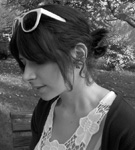 Science, Evil Eye and Gazing Science, Evil Eye and Gazing
I don't have a particular fondness for high tech gadgets, that is, for example, I am happy with my antique mobile phone that can neither go online nor take a photo. But today, I passed something that made me wish my phone did take pictures. I guess everyone has seen the new Nanotechnology building. It sits slightly behind the Main Campus Sports Center. This brand new building has the word NANOTAM proudly written in red on its front wall. What is remarkable about this scene is one tiny little detail: Just above the letter M, there is an evil eye, shining modestly in its blue-white-black color scheme.
For foreigners, I must first explain what an evil eye is. It is a subtle but powerful element of traditional Turkish culture. It is called nazar boncuğu in Turkish and the direct translation would be a "gazing bead." It does, in fact, look like an eye. This glass ornament can be seen almost everywhere in Turkey, from the windows of vehicles to the safety pins attached on the clothes of children. My grandmother had a habit of attaching one on my clothes all the time! This "eye" is supposed to protect the item or person that it wearing it from the jealous and evil gazes of others. It is said that this tradition goes back as far as the shamanistic beliefs of the Middle Asian Turks. It's been with us for thousands of years. And apart from the bead, the concept of the "gaze" is widely used in linguistic culture as well. Even those who don't believe it would use this term, Nazar değmesin ("Let the gaze be away from you"), in order to express their good wishes for something that is new or that they find beautiful, which they don't want to be harmed.
Yes, it's an essential, original part of our culture. But here's the question: What is it really doing on a building, the NANOTAM, which is built solely for the purposes of science? This place is supposed to be a sanctuary for ultra modern high technology, and I find it pleasantly ironic and very interesting to see such a traditional element on the walls.
Of course, the cultural studies researcher within me smiles with great pleasure. She tells me that nothing is strange about this, that there can be so many such examples because this is Turkey, the country I grew up and live in. This is a country of the people who would neither give up their naive traditions and customs of a thousand years, nor would they want to keep themselves from using the highly developed technology and lifestyles that the West has to offer. Yes, we are stuck between the East and the West - and we're obviously loving and enjoying it! And we deny the orientalist discourse - we prove that an evil eye and a facility of modern technology can actually coexist, they're not necessarily opposites!
My other side, the skeptical theorist-to-be, has different views. She thinks that once one is born under its shadow, one cannot escape the "gaze." The "gaze" here is, of course, not a blue bead. It is the dominant culture, a culture that we have to live with, whether we like it or not. You could choose to be paranoid and take this as the "Big Brother"s gaze, like in George Orwell's 1984, or you can see it as a normal element of everyday life; television is the gaze, print media is the gaze. We watch them and they watch us, they direct us and they shape us. Whatever lifestyle we choose to follow, we do not escape seeing, for instance, the fact that animals are brutally slaughtered in a specific time of the year on this land, because the gaze would remind us.
Two last notes: The gaze is actually a deeply established concept in social theory and philosophy of the 20th Century, you might want to check related entries on Wikipedia for an introduction. And, for an extremely good fictive read on the eye, the gaze and related concepts, I suggest Elif Şafak's “Mahrem,” which has an English translation called The Gaze.
By Damla Okay (COMD/V)
 |







